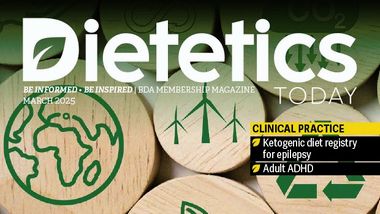The official BDA members' magazine
Dietetics Today is the official BDA members' magazine, posted out to arrive the first week of each month. It is the most valued BDA communication and features include; clinical articles, member stories, dietetics in the media, BDA campaign news, volunteer corner, student articles, membership updates, events and courses and lots more.
Latest issue and archive
Members can read the latest edition of their official members magazine Dietetics Today, bringing them latest news, views, updates and advancements from across the profession, plus insightful clinical articles, interviews and pilot studies. Hard copies are posted out to all members monthly, with student members receiving online access only.
BDA Blogs and member articles
A range of topical, informative and timely blogs from the BDA, BDA staff, members and guest writers aimed at BDA members. Some of these articles have been adapted from Dietetics Today.
How to submit an article for Dietetics Today
Any BDA member can write for Dietetics Today magazine. If you have already written an article and would like to send it in, just email the article to the editor ([email protected]) and the editor will assess its suitability for publication and will get in touch with feedback.
If you have an idea for an article that you would like to discuss, get in touch with the editor who will be more than happy to talk through your idea(s) and suggest a copy deadline and word count.
Writing articles for DT is a great way to let the membership know about important dietetic research, experiences, events and achievements. It’s a vehicle you can use to showcase your work and also contributes to your CPD.
Copy deadlines
If you would like to write for a particular issue of the magazine, simply select a copy deadline and submit the article. (Please note that if you are submitting an article for a particular issue, the editor cannot always guarantee that it will be published in that particular issue and may reserve it for a subsequent edition).
April
Copy to John: 23 Feb
Published: 8 April
May
Copy to John: 28 March
Published: 6 May
June (Dietitians Week)
Copy to John: 26 April
Published: 3 June
Jul/Aug (Sports Issue)
Copy to John: 28 June
Published: 5 August
September (Sustainable Sept)
Copy to John: 26 July
Published: 2 September
October (Student issue)
Copy to John: 23 August
Published: 7 October
November
Copy to John: 27 September
Published: 4 November
Dec/Jan
Copy to John: 25 October
Published: 9 December
The publication process
Once an article has been submitted, the editor will edit your article and may send you the edited version to check and approve (and sometimes revise if thought necessary).
The editor then sends the article to the designer.
The designer sends the editor a proof of the article. The editor will then proofread the article.
You will also be sent the proof to check and approve before publication. (Please note that the publishing schedule is very tight for each issue of Dietetics Today and although the editor will endeavour to send you the proof as early as possible to allow enough time for you to check it, sometimes proof checking requires a very quick turnaround and so please keep checking your emails regularly to look out for your article proof.)
Please also note that only main features and longer articles are sent to the writers to approve. Shorter ‘news’ type articles are not always sent to the writer to check.
Once the editor receives your feedback and corrections for the proof, the changes are made and the article is ready for publication. (In some cases you may be sent a second proof to check if queries have not been resolved in the first instance.)
Become a reviewer
We often feature reviews of books or apps in the reviews section of DT that you might find interesting or useful. If you would like to become a reviewer please email the editor your details and if you have any particular area of interest.
Writing tips for Dietetics Today
You will be reading this because you want to write for Dietetics Today or have been asked to produce an article for the magazine. Before we get down to the practical tips on how to produce a good article, there a few points you should consider before starting:
- Is the article topic original?
- Why are you about to write this article?
- What is the purpose and key message for the audience?
- Is the subject matter thought-provoking?
- Will the article have wide appeal to BDA members? Why?
Practical points when submitting your article:
The article should be typed in Microsoft Word and emailed to the editor: [email protected]
It is helpful if you submit an article with a file name such as your surname and topic, e.g. ‘Jones_Eating Disorders’.
Please supply a photo of yourself with the article (a head shot in JPEG format).
Writing tips:
Heading
Give your article an attention-grabbing headline. If you can’t think of one straight away, try and come back to it after you have written the article.
Introduction
Your introduction to the article needs to grab the browser’s attention; it needs to engage the reader instantly by clearly stating what the article is about. Attention-grabbing techniques can include: presenting an interesting fact, posing a question, stating an opinion. The introduction needs to encourage the reader to stick with the article. The introduction is not a summary of the article, and should contain only two or three facts.
Paragraphs
Long paragraphs can put a reader off. Keep paragraphs to four sentences or fewer. Start a new paragraph each time you make a new point.
Language
Dietetics Today is read by many dietitians who hold down very busy jobs. When they read DT, we want to make it easy for them to digest the information they are reading rather than using overly complex language that makes reading and understanding more difficult. So, please use plain English when writing. As a general rule, use short words rather than long ones.
Sentences
Use short sentences. They make text a lot easier to read. Keep your sentences under 25 words.
Active voice
We prefer the active voice in articles. The active voice is clearer and uses fewer words. In the passive voice, subjects are having things done to them. In the active voice, the subjects are doing things. For example:
The mat was sat upon by the cat. (passive)
The cat sat on the mat. (active)
Reader engagement
While writing, think about how you can keep your readers hooked to the article. The reader should feel like they have learned something new or been on a journey. Use interesting facts, questions and descriptions in your writing. Use emotion where relevant; the reader needs to feel your passion for the subject you are writing about.
Subheadings
It’s easier for readers to digest information if the copy has regular breaks in it. Use subheadings to break up the text and give the readers time to digest what they have just read. Subheadings also introduce what to expect next and clarify what is in the following copy.
Quotes
Use quotes to make your article more interactive and engaging. If using direct quotes from colleagues or other people, please remember to ask their permission.
Referencing
Please use the Vancouver system for referencing rather than Harvard.
The Vancouver system is where references are numbered consecutively in order of appearance in the text – they are identified by Arabic numerals in superscript1. Different formats exist for different types of sources, e.g. books, journal articles and so on.
There are lots of useful websites that will guide you how to use the Vancouver system. If you have difficulties with this referencing style please contact the Dietetics Today editor who can talk you through it.



